One of the most majestic experiences you can have with trees is being surrounded by old-growth Tulip Poplar trees. Tulips grow extraordinarily tall and straight, with thick gray trunks and spreading roots. You feel like you are in a cathedral, standing under these magnificent trees. The tulip trees get their name both from the leaves–which are shaped like a tulip and from their flowers–beautiful, large, showy orange and yellow flowers that look just like a tulip. You can find these trees easily in June as the showy tulip leaves begin to drop to the forest floor. They are also easy to spot in the winter–you can look up and see the remains of the tulip flowers, gone to seed, throughout the winter months–they look like little cups reaching up to the heavens, a beautiful sight.
We have one such grove of tulip trees in a local park near here–a local park called White’s Woods. Unfortunately, some township commissioners want to harvest a lot of these magnificent trees, so our community has been in a battle to save our forest for over a year now. What has amazed me about this entire fight, however, is how the tulip tree has become the symbol of the forest: people have gone to the woods, taking photos of the trees, hugging the trees, and more. I have faith that we can win this battle to save our majestic tulip forest!
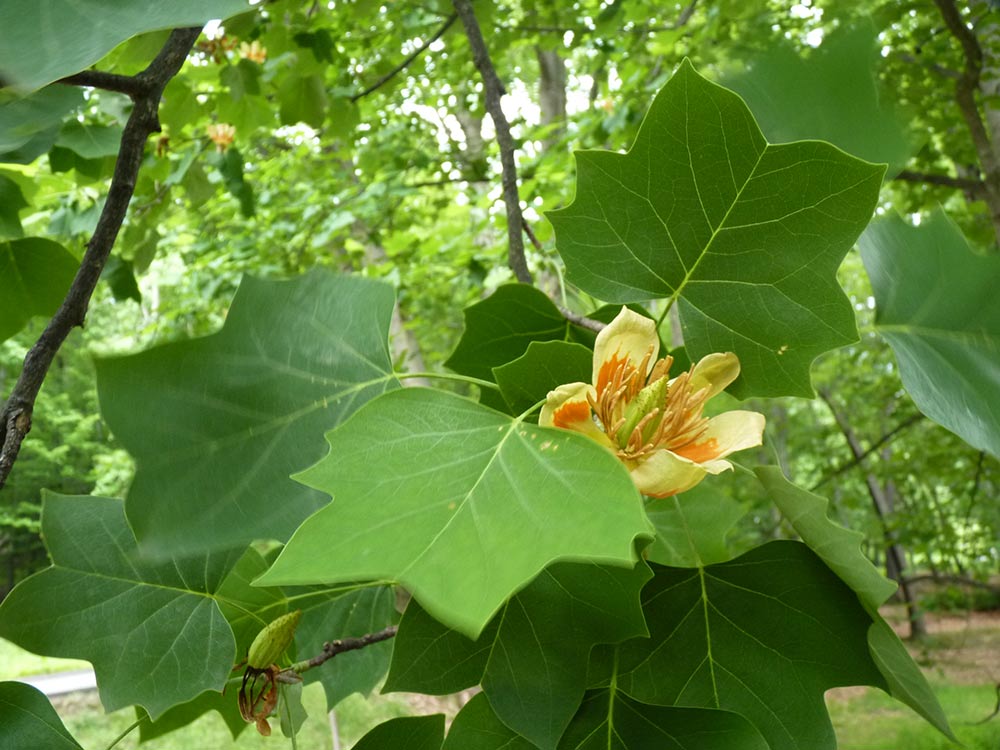
The Tulip tree is known by many names–here in Western Pennsylvania (USA) we use the term “Tulip” (which is how I’ll refer to this tree in my post). Further out east and in the south, I’ve heard it called “Tulip Poplar.” In his book A Reverence of Wood, Eric Sloane notes that it is also called “Whitewood”, “Yellow Poplar”, or “Popple.” It is also known as “fiddletree” and “canoewood” for reasons that will be apparent in this post. The tree has a large range throughout the Mid-Atlantic states and upper Midwest (New York, Pennsylvania, Michigan, Ohio, Indiana) and across the south, stretching along the coast and to the Mississippi (Kentucky, Alabama, Georgia, Tennessee, the Carolinas) and into Florida. Whatever your name for this tree–let’s spend some time today getting to know the ecology, mythology, and magic of this most wonderful tree. The magnificent tulip trees throughout North America have much to teach us, if only we listen.
This post is part of my Sacred Trees of Eastern North America series–here you can learn about the many wonderful trees upon on our landscape. In this series, I explore the magic, mythology, herbal, cultural, and divination uses, with the goal of eventually producing a larger work that explores many of our unique trees located on the US East Coast (which I hope to have completed by early 2022–so you will be seeing a lot more tree posts!) For my methods, you can see this post. Other trees in this series include Spruce, Spicebush, Rhododendron, Witch Hazel, Staghorn Sumac, Chestnut, Cherry, Juniper, Birch, Elder, Walnut, Eastern White Cedar, Hemlock, Sugar Maple, Hawthorn, Hickory, Beech, Ash, White Pine, Black Locust, and Oak. For information on how to work with trees spiritually, you can see my Druid Tree Working series including finding the face of the tree, seeking the grandmother trees, tree relationships, communicating on the outer planes, communicating on the inner planes, establishing deep connections with trees, working with urban trees, tree energy, seasonal workings, and helping tree spirits pass.
Ecology of the Tulip Tree
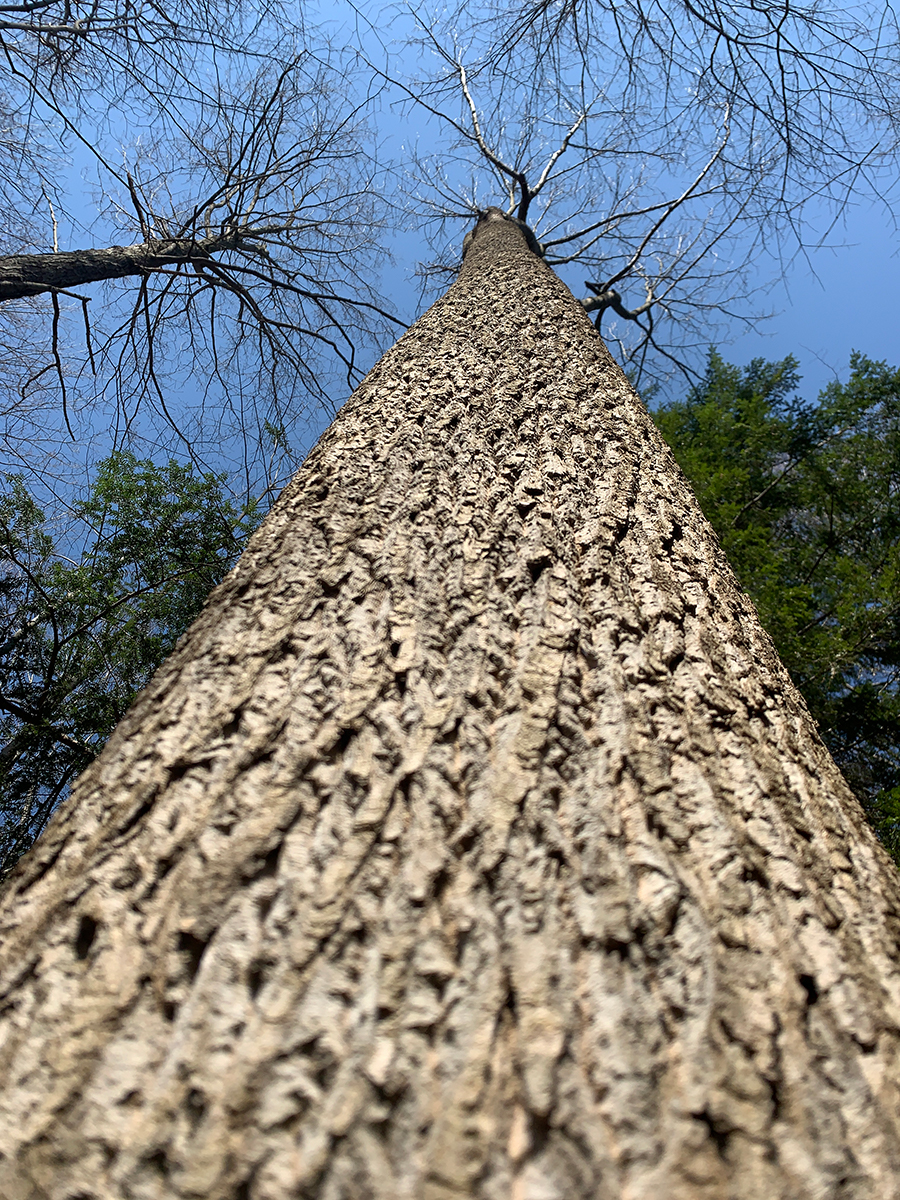
Despite the fact that they are commonly called a poplar, tulip trees are in the magnolia family, and thus, share some qualities with other magnolias, including the large leaves and showy flowers. The Tulip tree is characterized by an extremely tall and straight growth habit and is one of the largest trees in North America. The tree has a large range throughout the Mid-Atlantic states and upper Midwest (New York, Pennsylvania, Michigan, Ohio, Indiana) and across the south, stretching along the coast and to the Mississippi (Kentucky, Alabama, Georgia, Tennessee, the Carolinas) and into Florida. In extraordinary cases, they can grow up to 170-190 feet high, although the average is still about 160 feet tall. The Tulip has several key features that make it a really incredible tree: it grows fast; it has strong, light-colored wood; the wood is not brittle or weak like many other fast-growing trees; and it grows straight and tall. The base of the trunks often flare out and then meet the tall-growing trunk—this is why they are called “fiddle tree” as their root base and trunk can appear to look like a fiddle from the distance.
The tulip tree is considered a “mid succession” tree from an ecological perspective. They are shade intolerant, so they grow fast and usually come into dominance 50-150 years after a forest regrows. As the climax species take over (hardwood nut trees: oaks, hickories, etc.), they will decline. Thus, you can use Tulip to help read the age of a forest and have a sense of a forest’s history. Here in Western and Central Pennsylvania, this is particularly useful: we had almost 92-98% of the forest cover cut due to industrialization from about 1880 to 1920. So we are in that 50-150 year range where we have many beautiful large stands of Tulip trees.
The other interesting thing to know about history is that the tulip is a very ancient tree representing older forms of tree life. The Tulip tree has an older, less evolved seed pod than other more recent trees, which also accounts for its unique flowers. We have fossils from ancient tulip trees from the upper cretaceous period (70-100 million years ago); from that fossil record, we know that it once was much more widespread but now only two species remain in the Liriodendron family: the North American Tulip Poplar tree and the Liriodendron Chinese, which grows in China and Vietnam. It is likely that many Tulips were destroyed in glaciation in the Pleistocene era.
The trees begin to flower in June here in Pennsylvania, but you might see flowering as early as April in much warmer southern states. The flowers range from light yellow to light green and have bright orange in their centers. I’ve seen photos of tulip trees with almost white flowers, but nearly all of them where I live are light yellow as the photos I am sharing suggest. The leaves also look like a tulip–the leaves grow in an alternate pattern and are 5-6″ wide, heart-shaped, and have four lobes looking like the points on a tulip flower. They are quite distinctive here in the Eastern US–no other tree has a leaf anything like Tulip, making them easy to identify. In the fall, they have brilliant yellow foliage that is brighter but the same kind of yellow as their flowers earlier in the year. Their bark is brown and has many deep ridges as the tree ages—they almost look like the ridges here in the northern Appalachian Mountains, running parallel along the landscape. Younger branches are smooth and reddish and later grow into the darker brown.
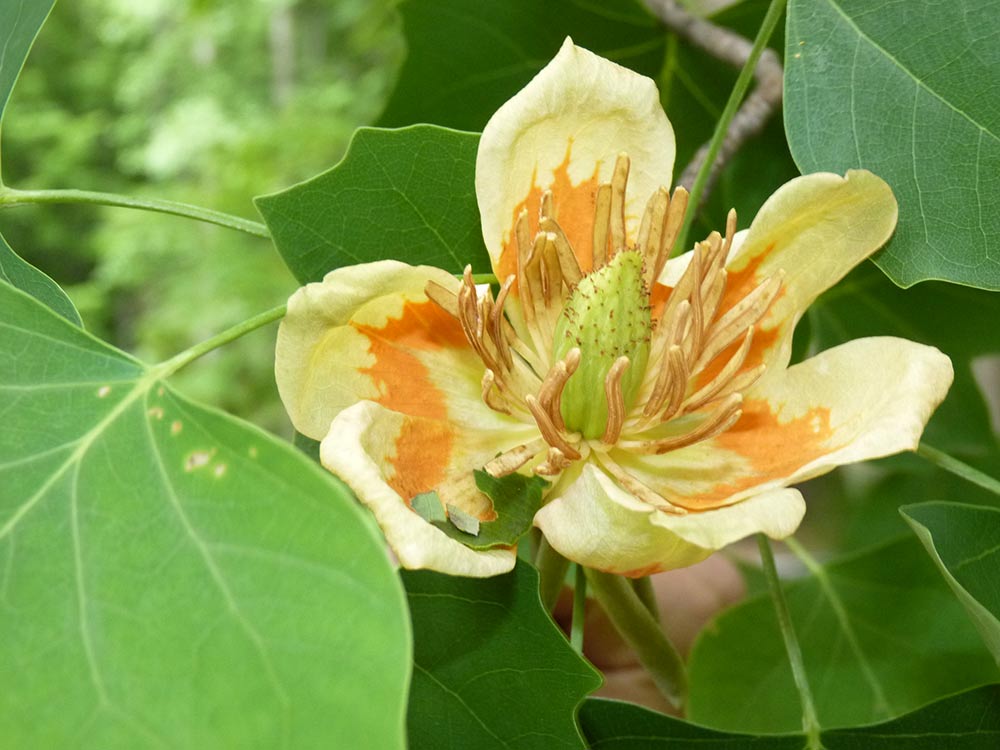
John Eastman describes some of the ecologies of these trees: they are often found with beeches and maples. I have also seen them here with Cherries and some limited hardwood nut trees (oak, butternut). Eastman says you can find them in bottomland forests, but here, we see them growing along wet hillsides and slopes. Birds including cardinals and finches, consume the seeds in the winter along with squirrels and mice.
Human Uses
Tulip tree is one of the most valuable hardwoods in North America due to its quick growth, straight growing habit, and strong wood. In the US, it is usually marketed as “poplar” but abroad it is sold as “American tulipwood.” It is used for instruments, like organs and pianos, and can also used as interior finish/veneer, used for wide floorboards, boxes, bowls, and more. It is comparable to White Pine and usually more abundant due to its distribution and growth habitat. It resistance to termites and thus, can be used for barn and house beams (I’m not sure I’d use this over black locust, but it is still a great wood!) The wood is nice to work and doesn’t split. Charlotte Erichsen-Brown notes that in Pennsylvania, natives and colonists alike used it for canoes, boards, planks, bowls, dishes, spoons, doorposts, and joiners roofs because it was so easily worked and strong.
Tulip tree is well known in the bushcraft communities for a wide range of uses. Tulip inner bark (cambium) is an excellent emergency food (which I have not tried); the inner bark can also be used as an excellent tinder to make a nest for starting a fire using a bow drill, hand drill, or flint and steel (which I have tried). You can use a single tulip poplar downed branch to start a warm fire: stripping the bark for kindling and your nest, and then using the branch wood itself to start the blaze. You can also make a nice bow drill set from tulip poplar—it is harder than a beginner set (made of something soft like paw paw) but is a great for both a hearth board and a spindle. The inner bark also can be twisted into a rope or cordage. Tulip bark, when freshly cut, can be cut and peeled in the spring, so you can use it to make really nice bark baskets, arrow quivers, and more. It is also a very popular carving wood for spoons, bowls, and other functional crafts. I often will hike through the forest and look for downed tulip trees, eagerly ready to harvest their bark if the chance permits! Here’s an overview of some of the uses.

Tulip poplar makes an excellent early to midseason food source for bees, and you can sometimes find honey from Tulip trees at local farmer’s markets.Tulip flowers also have some nectar that is in the cup that can be enjoyed directly—but best of luck trying to find low hanging flowers for your to enjoy. I’ve only had a chance to taste this very infrequently in my foraging travels because usually the flowers are 150 feet up the tree! Speaking of foraging, you might get lucky and find morel mushrooms near or under these trees as this is one of the common places they grow.
The Native Americans used this tree extensively for a range of uses as described by Charlotte Erichsen-Brown in Medicinal and Other Uses of North American Plants: A Historical Survey with Special Reference to the Eastern Indian Tribes. For example, one name of this tree is “Canoewood” which refers to the fact that many Native American tribes, including the Harriot in Virginia, used the massive Tulip tree trunks for making large dugout canoes (using fire-based methods). Captain John Smith in 1612 described these canoes as being 40-50 feet in length and carry 40 passengers. This, most certainly, is how the tree got its name “canoewood.”
Tulip Poplar Medicine
The tulip tree is really a tree that keeps on giving and helping humans in so many ways, and that includes a range of medicinal treatments.
Matthew Wood in The Earthwise Herbal: New World Herbs notes that the tulip tree bark is used primarily for medicine. The bark is sweet, acrid and aromatic. Quinine, which is a very effective Malaria treatment, was made from the Cinchona tree—in the absence of Quinine, you can use the bark of the Tulip tree. Tulip tree contains salicylates, which, along with Willow and Birch, can be used for pain relief. It can also be used to support digestion, restore people to health after they are worn out with fever and tension, strengthen and calm the heart/cardiovascular system, and also supports arthritis. Other modern uses of this tree include using the leaves as a poultice for sores or scrapes. The inner bark can be used to support a healthy fever and to aid in digestion. The inner bark can help treat pinworms or other worm issues.
Traditionally, as Erichsen-Brown notes, the leaves can be crushed and placed on the forehead to help with a headache. The Osages collected the bark in the winter months for a range of treatments–the winter bark has a higher medicinal content. A bark decoction (strong tea) can be used as a dewormer for horses, as a powerful blood purifier (alterative), and for treating a variety of stomach conditions. The inner bark of the root is considered the most powerful, but any of the inner bark can work for these purposes.
The Magic and Mythology of the Tulip Tree
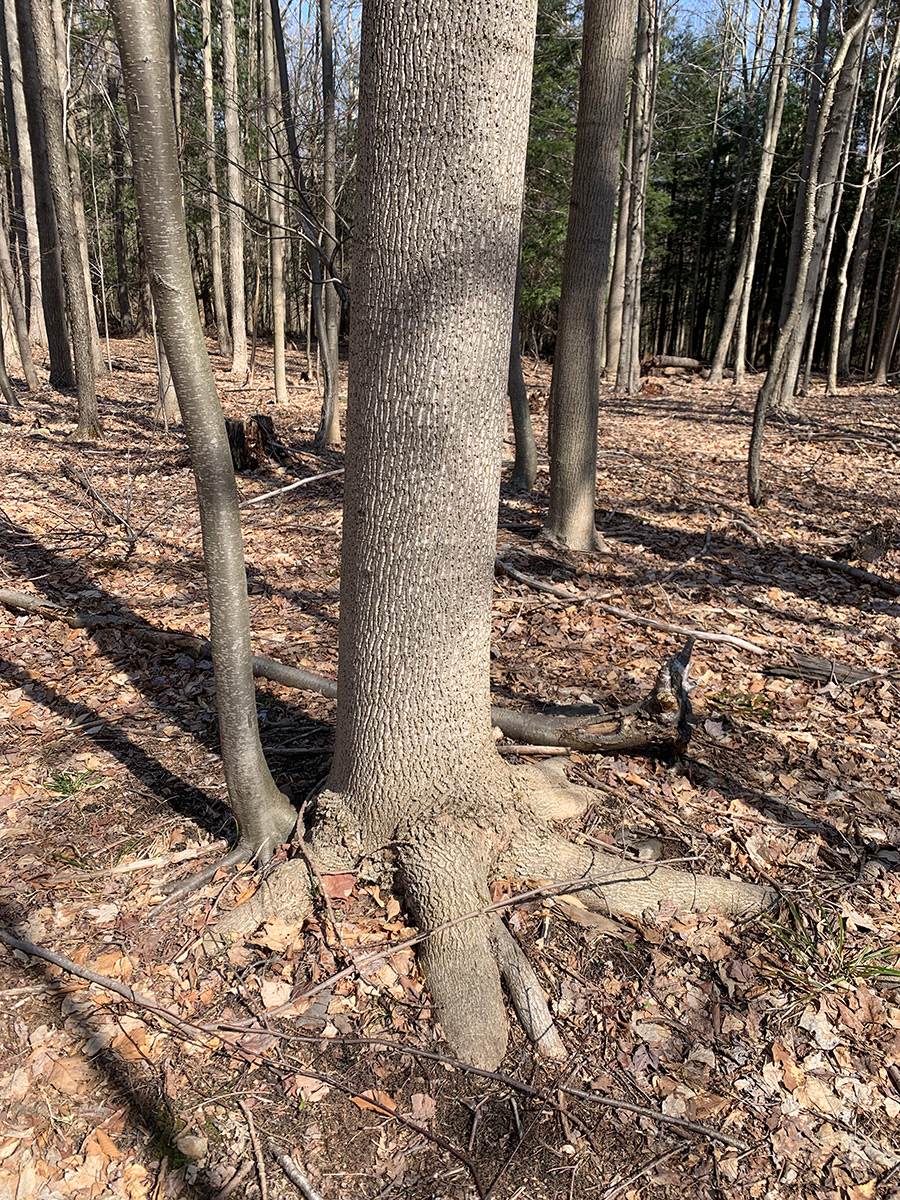
The Tulip Tree does not appear to have any recorded uses within the traditional Western magical traditions: in consulting my giant pile of usual sources, I do not see it listed at all. This is honestly the case with many Northern Appalachian trees I’ve been covering recently in this series–if they do not have an old-world equivalent or if they are also not located predominately in the deep south, they have no record of magical use. This doesn’t mean that they aren’t magical–Tulip is a magical tree! It just means that it does not appear to have use in Hoodoo or traditional Western Occultism. In a similar manner, the Tulip isn’t discussed in the Native American lore that I can find in any way outside of the utilitarian uses.
One small tidbit: the American poet, Walt Whitman, indicated that the Tulip Tree was the ““the Apollo of the woods–tall and graceful.”
Magical and Divination Uses of the Tulip Tree
Given the lack of sources on magical uses, we have to draw upon the doctrine of signatures, the historical uses of tulip, the ecology, and growth habits to explore some possible magical and divination uses for the tree. Here are three possibilities:
Utility and Practicality: one of the things about the tulip tree is that it has a tremendous amount of utility: it grows fast, produces amazing food, shelter, and medicine, and it offers bountiful—yet—utilitarian gifts to all who seek them. This is a tree that encourages us to be practical and to think about utilitarian uses rather than frivolous ones.
Mid-succession and Transition: I think that the fact that the Tulip is a mid-succession tree is important to its potential magical qualities. Trees often take on specific qualities depending on if they are first-aid responders / land healers, mid-succession, and pinnacle species. As a Mid-succession tree, Tulip occupies a very important place in the larger lifespan of a forest: it helps us move beyond the first responder trees, carrying on from their early work. It holds space for a period of time, and preparing the way for what is to come. When I think about a lot of work that many of us do as land healers, permaculturists, herbalists, and druids—I think about us now as having this kind of energy. The past is gone, and with it, a lot of knowledge was lost. We are in a very difficult time of transition and suffering for nature, but we are here to hold those spaces and help aid in the transition. Whatever is coming, we are not there yet, but we are holding space in this time and place for what is to come. The Tulip tree tells us to stand tall and strong in this regard!
Connection to Ancient Ancestors: Because the Tulip is such an ancient tree, it can connect us with our ancient human ancestors, those whose ways and names are lost to the mists of time. That reminder is in every seed pod and flower, and certainly, in the roots of these magnificent ancient trees. They have survived an ice age, they have witnessed countless changes over hundreds of millions of years, and they stand with us today to share that ancient wisdom and bridge to tomorrow.
I hope you enjoyed this deep dive into the Tulip Poplar tree! If you have any stories, information, or ideas about the Tulip tree, I would love to hear from you. Blessings!
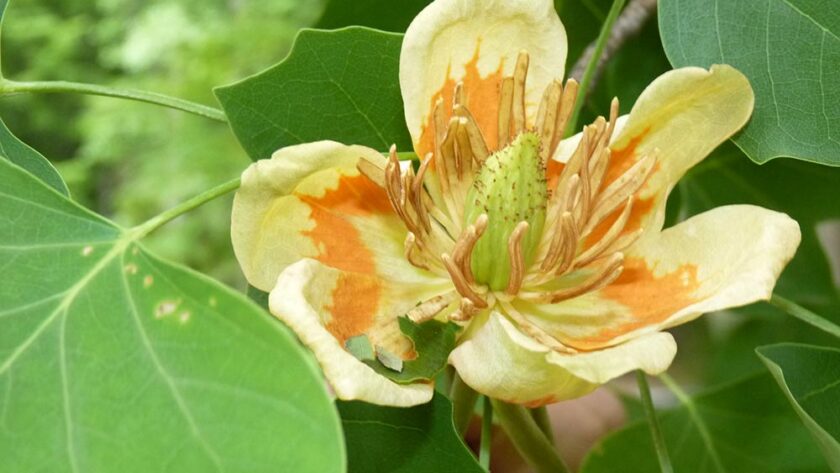

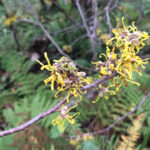

I grew up with a GIANT tulip poplar right by my house! My dad hates it. A few limbs dropped on our house like twice in the last 30 years. How can I find out how old the tree is? I feel like knowing the age will help my dad respect it…
Hi Rachel,
Great question! Trees have different growth habits based on if they are growing in a forest vs. growing alone, like in a yard. You can measure the circumference and then use this guide to help you figure out how old it is:
https://www.hunker.com/12001364/how-to-tell-the-age-of-a-tree-without-cutting-it-down
Tulip Poplar has a growth factor of three (which you need to use the information at the link above!) 🙂
The book by “To Speak for the Trees” by Diana Beresford-Kroeger, has a page on the Tulip tree and how it was cut down in a widespread way in Canada. And that the Huron Indians used it medicinally and considered it sacred and made their death masks out of it. https://www.google.com/books/edition/To_Speak_for_the_Trees/IZ-rDwAAQBAJ?hl=en&gbpv=1&dq=tulip%20tree%20huron%20death%20masks&pg=PA133&printsec=frontcover&bsq=tulip%20tree%20huron%20death%20masks
Hi Elkcircle, thank you so much for sharing. Did Diana’s book describe why the tulip was cut down in a widespread way? I know its a very valuable timber tree….here in PA for example, its one of the best timber woods, sometimes even poached off of public lands!
Hi Dana, the author Diana Beresford-Kroeger talks about how settlers to Canada did clear cutting on the good land in order to farm. She mentions the colonial authorities (the English) required settlers to cut down all the forest on land before they could own it. (p 140 in her book To Speak for the Trees). She was taught in Celtic wisdom as a child and now works to do re-foresting. She collects specimens of trees and grows them on her farm in Canada.
Ah, got it. I’m not surprised that there was some terrible government policy that required them to completely strip the land bare before they could plant! Thank you for sharing.
It is interesting/frustrating the lack of Western magical wisdom regarding New World tree species. I really appreciate this article – I’m going to check your archives to see if you have anything on Sweet Gum. I’ve lived in the south off and on where we do call this tree a tulip poplar. I grew up with a big old one in the yard. Last night a storm blew a flower and some leaves into my yard and got me thinking about the metaphysical meanings of this elegant tree. I think you are spot on in your interpretation and would like to add that due to the orange/yellow color of the flowers and their emergence mid spring (at least here!) I feel like the tree has an energy of industry and work ethic – not the modern gross meaning of the word, but more like an ant collecting food for the colony or a bird building a nest. To take full advantage of the potential of spring in order to have future abundance. Do you get that energy too?
Hi Loquin, yes, I totally get that energy from Tulip! I think that’s also really consistent with the wide range of bushcraft uses too 🙂
I love the Tulip Poplar tree. It’s the tree of my heart. <3 And I love your honoring of it here. Thank you. In my own experience with this tree, I have received so much medicine from it for the body but also the soul and the heart. It is Magic — and I continue to find it so curious that so little seems to be known or shared about it in this way.
You are welcome to enjoy some of its medicine here: https://open.spotify.com/show/2q4YHwhzR5XY1PnIOOu9pW?si=be0c73aad8954342 Many episodes of the Whispers: Plant Spirit Medicine podcast are dedicated to the medicine of Tulip Poplar. And I have begun to write more about it more here: https://amandanicole.substack.com/?utm_source=substack&utm_medium=web&utm_campaign=substack_profile
I have saved your page so I can absorb more of its physical medicine as my experience has so much emphasized its other expressions.
Hello Amanda Nicole, thanks so much for sharing and the link to the Whispers Plant Spirit Podcast! Wonderful–I’m happy that you also share in the wonderful magic of this beautiful and powerful tree. Blessings!
Thank you for your well researched appraisal of this wonderful tree. I have to cut a few down that have been damaged or grown too close to my house and am researching how to make good use of their parts. If I have to cut them, they need to be appreciated in other ways. I just felled and stripped the bark from one today and tried chewing some and made a tea from a mix of inner bark and leaves. It was quite stingingly bitter, but I enjoyed the aroma quite a bit. I might try making a bowl. Unfortunately, none of the trees are big enough to make a canoe out of. Of course then I’d be really hesitant to chop it down!
Thanks again for your wisdom. I’ll stay open to their magic as I spend time with these beautiful industrious trees over the coming weeks.
Hi Nathaniel, glad the post could be helpful to you! And blessings as you look to make use out of this amazing tree :).
I consciously encountered this tree for the first time today and am enchanted. Thank you, Dana, for the way you honor the tree, and for the depth and breadth of wisdom and beauty you shared about it. I’m grateful it lead me to your work (I am of Irish descent and yearning to reconnect to the ancestral wisdom of my lineage).
Hi Laureen, I’m so glad you were able to meet the tulip poplar! I would love to hear more about how this tree has impacted your life and the story of meeting the tree if you are willing to share :). Blessings to you.
Hi Dana, I have heard that the flowers are edible. I can’t locate any information about this, though. Are you aware of any? Thanks.
Hi Kathy,
YES! Specifically, when they are in bloom, there is usually a little bowl of nectar in the bottom. You can drink this. But the flowers are also safe to eat. Most people don’t get to drink the nectar becuase the Tulip Poplars are really tall and it is often hard to reach them :). Blessings to you!